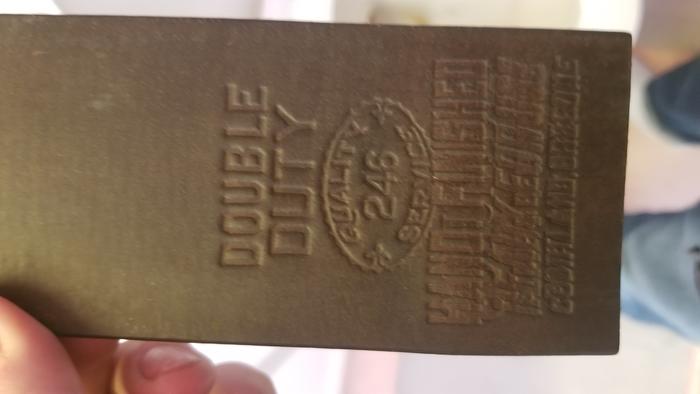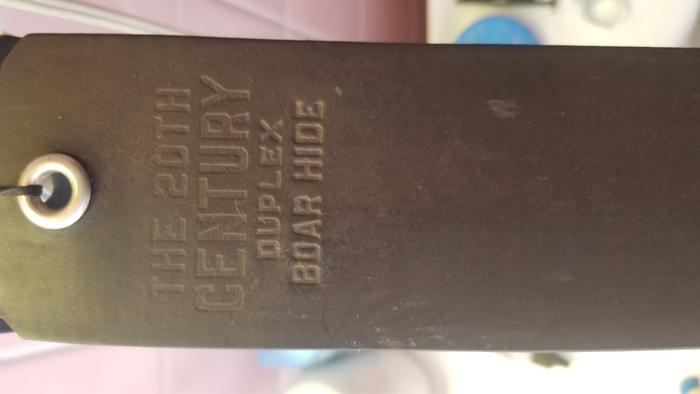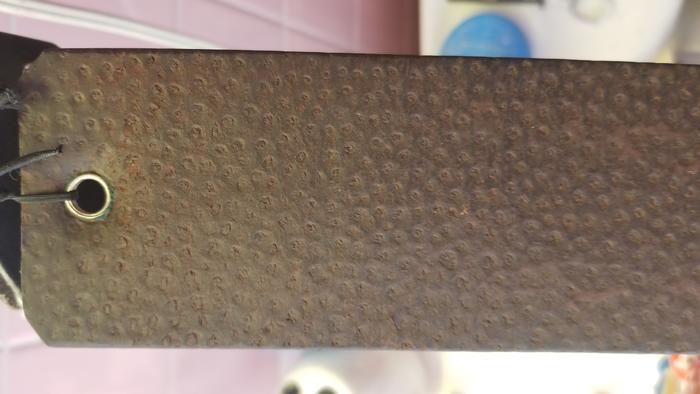Results 1 to 10 of 16
-
03-02-2020, 10:20 PM #1Senior Member

- Join Date
- Feb 2016
- Location
- Pittsburgh, PA
- Posts
- 171
Thanked: 17 Restoring vintage strop, improving draw
Restoring vintage strop, improving draw
I have been restoring an old boar hide strop for a few months now. Bought it at antique store for $1, dirty as hell and stiff and dry as could be. Wanted to try resurrecting a vintage strop and end up with what I considered an uncommon material.
Started with good cleaning with arko shave soap thick lather and got all the dirt off. Been wiping with a damp sponge every other day or so to slowly rehydrate. Rub a few drops of neatsfoot oil in every couple weeks.
It looks good, leather is now flexible and supple, but the draw is still really glassy, like stropping on tile. Even just after oil or water when you'd expect it to be more grabby.
Does anyone have any advice on how to improve the draw? Was thinking of sanding with a high grit, or scotchbrite pad or something. Hate to ruin it at this point though.
Thanks.
-
03-02-2020, 10:27 PM #2Senior Member



- Join Date
- Apr 2012
- Location
- Diamond Bar, CA
- Posts
- 6,553
Thanked: 3215
Post some pics of the strop.
-
03-02-2020, 11:41 PM #3

I used to have a boar strap. It's mighty tough hide so you really can't get a soft effect on the surface minus chemical treatment however it still does it's job.
No matter how many men you kill you can't kill your successor-Emperor Nero
-
03-03-2020, 06:48 AM #4

Restoring strops is not easy.. For me at least.
I cleaned a shell strop a few years ago. It still hangs in the cupboard un-usable.
I would have thought slippy slidey would be better. Maybe add a suede piece. Then you can go with draw and then without..
-
03-03-2020, 09:40 PM #5Senior Member

- Join Date
- Feb 2016
- Location
- Pittsburgh, PA
- Posts
- 171
Thanked: 17
Here are some pics, one "before" and a few current ones. I think I'm gonna lay off the remoisturization efforts and concentrate on hand stropping and maybe some tallow soap to try to just liven up the surface.




-
03-04-2020, 09:44 AM #6

Wow. I really need to get to an antique store.
-
03-04-2020, 04:00 PM #7Senior Member



- Join Date
- Apr 2012
- Location
- Diamond Bar, CA
- Posts
- 6,553
Thanked: 3215
The goal of leather strop restoration is two-fold. 1 rehydrate the leather without rotting, (go slow). 2 once rehydrated, clean the leather and re condition the face.
You can test the strop surface, by taking a folded clean paper towel and rubbing the surface and see what comes off.
You can also test for grit by stropping a polished bevel and see if it scratches the bevel
Polish a bevel with a good metal polish. Make a paddle strop from a piece of cardboard, inside of a cereal box. Paste 3-inch X’s, 3 inches across one edge, then strop a razor or knife bevel on the edge of a table or workbench.
About 100 laps will remove all the visible stria from the bevel of an 8k edge. 60-100x magnification will help, a Carson MicroBrite 60-100 scope is $10-15.
Now strop on the on the strop and see if it scratches the polished bevel.
Once you have hydrated it and it has enough body that it will not fall apart when wet, you can clean it with Murphy Oil Soap or Dawn dish liquid. The color of the lather will mark your progress, dirt and grit is black-er, leather and dye more brownish.
Work with a brush and clean damp sponge, I use a soft fingernail brush. Work soap into the leather, laying the strop on a flat work bench and wipe off the lather with a damp, warm sponge. Rinse well with the sponge to remove as much of the soap and dirt as possible. Buff with a folded clean paper towel. If needed repeat the soap suds treatment, use as little water as possible.
Try not to get the leather too wet, Re-hydrate with oil, I use a 2-ounce, PET spray bottle with Neetsfoot, Ballistol or Olive oil. The 2 oz bottle delivers about a ¼ tablespoon per squirt. Hold the bottle up close to the strop when held vertically. I use 3-4 sprays, one near the top, one near the bottom and 2 in the middle. Spray on a damp strop, and quickly with a damp hand rub into the leather, blending the 3-4 squirts. Spray both sides and spray some on your hand and wipe the edges.
I have lately been using Olive oil, buy the cheapest you can find, but make sure it is 100% olive oil. does not need to be virgin oil. I bought a 2-quart tin, from Home Goods a home décor outlet store for $5. The olive smell goes away after a few hours.
Let the strop dry for about 30-60 minutes then roll the strop on a hanging rolling pin. Rolling will loosen the fibers and allow future oiling to penetrate deep into the leather, make the strop soft and flexible and increase the draw.
There is an old post on rolling a cleaned linen strop, the same procedure is use for leather. Go slow when bending the strop over the rolling pin, if you feel cracking, you need more hydration. If you roll a dry strop you can break the fibers instead of stretching them. It may take a few sessions of rolling to get a strop fully limber, you should be able to roll it easily into a U shape on the roller when finished. It should be as floppy as a well washed sock.
After a couple lathering’s, let the strop dry out for a day. It may take several sessions of soap cleaning to remove most of the grit imbedded in the leather. Dust is super fine and if exposed for years can be difficult to remove, don’t try to do it all at one time, the leather will get too wet, let it dry a couple day between cleanings.
Once dry and as much of the grit is removed, you can recondition the face, by scraping, sanding or waxing depending on what is needed and draw you like.
I scrape the face with a sharp cabinet scraper on a flat work bench. You can use a large sharp kitchen knife. Clamp the strop to a flat surface, use lite pressure and make a single stroke from top to bottom to lightly remove/scrape a fine layer of leather and any remaining surface grit.
Here again, go slow. Scraping will produce a fine napped surface, similar to a fine suede. If you do too much, sand with 400-600, clean, Wet and Dry wrapped around a large wood dowel, piece of large plastic pipe or plastic bottle, (a 1.5-inch, RX pill bottle works well) to reduce the nap. Roll the tube slightly to keep fresh paper on the strop.
If you want a slicker finish you can wax with shoe wax, or a good saddle soap, a little goes a long way, rub it in dry. Saddle soap has bees wax in it.
Once you get a finish you like you may still need to continue to hydrate with oil, depending on how dried out the strop was. It can take up to a year or more, adding oil once a month or so, before it will stabilize.
Increasing the draw is a dance between hydration/ oiling and surface condition, take your time with both. The bottom line is not so much how the draw feels, as the edge it produces.
-
The Following 2 Users Say Thank You to Euclid440 For This Useful Post:
AlanQ (03-05-2020), Montgomery (03-08-2020)
-
03-04-2020, 11:33 PM #8Senior Member

- Join Date
- Feb 2016
- Location
- Pittsburgh, PA
- Posts
- 171
Thanked: 17
Holy crap Euclid, that was thorough, thanks.
To be honest I was adding a bit more neatsfoot than a few drops, closer to what you are saying. A drop or 2 would get absorbed instantly with no ability to be spread. I used a bottle similar to a bingo dauber to apply to a dampened strop.
This is a lot longer, more painstaking, drawn-out process than I envisioned but it has also been rewarding thus far.
I have passed on alot of similar strops at flea markets and such in the past, I might not pass after this.
-
03-05-2020, 02:16 AM #9

Just posted my new finds along with a question about strop restoration and then saw this thread. Questions answered
Seems it is my lucky day
-
03-05-2020, 03:02 AM #10
 No matter how many men you kill you can't kill your successor-Emperor Nero
No matter how many men you kill you can't kill your successor-Emperor Nero


 49Likes
49Likes LinkBack URL
LinkBack URL About LinkBacks
About LinkBacks






 Reply With Quote
Reply With Quote

